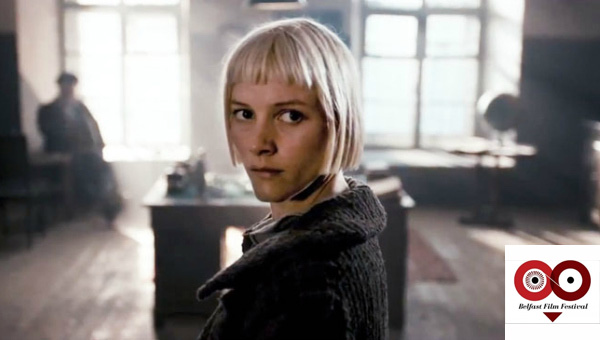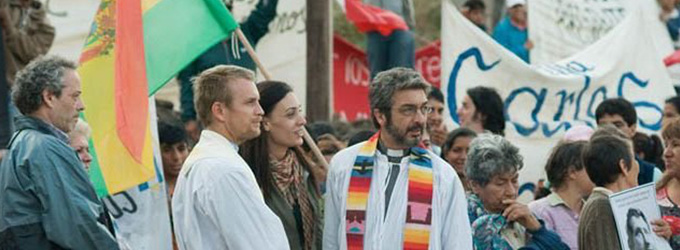WHITE ELEPHANT- Pablo Trapero
THE WATCHTOWER – Pelim Esmer
UNA NOCHE – Lucy Mulloy
SPOOF OR DIE – Prasanna Puwanarajah
THE FIFTH SEASON – Peter Brosens and Jessica Woodsworth
A HIJACKING – Tobias Lindholm
VANISHING WAVES – Kristina Buožytė
RADIO FREE ALBEMUTH – John Alan Simon
PURGE – Antti Jokinen
LIKE SOMEONE IN LOVE – Abbas Kiarostami
FINAL CUT – György Pálfi
It’s undoubtedly a generalisation that can be disproved just as easily as it’s asserted, but the personal impression I always take away from a Belfast Film Festival is one of a programme of intense, gritty and challenging new international cinema. The 13th Belfast Film Festival 2013 was no exception. I may have decided to ease myself gently into the festival with a showing of Franco Zeffirelli’s sumptuous 1982 film version of Verdi’s LA TRAVIATA projected at St Anne’s Cathedral, one of several scene-specific showings that included COOL HAND LUKE at the Crumlin Road Jail and THE BREAKFAST CLUB in the school library at the Royal Belfast Academical Institution (popularly known as Inst), but my opening New Cinema showing of Pablo Trapero’s latest feature set a more realistic tone for what was to come, as well as setting the bar very high for the films in the remainder of the festival.
…the impact of the drama hits you like one of the city’s sudden thunderous downpours.
Even by the Argentinean director’s standards, with films like the brutal and painful women’s prison drama LION’S DEN, WHITE ELEPHANT sees Trapero at his most intense and further developing his technique. Based on a true story, WHITE ELEPHANT is set in a Buenos Aires slum where two Catholic priests have to overcome their own personal issues for the sake of a population oppressed by heavy-handed police action and gangland violence between the neighbourhood’s drug lords. The film may rely on a few familiar dramatic devices to give it a sense of narrative structure in this respect, and it has a few big-name actors like Ricardo Darín, Jérémie Renier and Martina Gusman to carry it, but for the most part Trapero depicts the reality of the harsh living conditions and social deprivation with an open documentary-like approach that is refreshingly devoid of cinematic academicism or narrative sentimentality. The themes and the purpose of the film are more often allowed to surge from the screen much like the violence that erupts without warning between the drug cartels, and the impact of the drama hits you like one of the city’s sudden thunderous downpours.
Mulloy’s film very quickly demolishes any picture-postcard image of Havana as a romantic tropical haven…
By coincidence, the film I saw after WHITE ELEPHANT had a character background trauma that is nearly identical to the one used in Trapero’s BORN AND BRED. Instead of heading to Patagonia however to deal with a similar tragic event in his life, Nihat in Pelim Esmer’s THE WATCHTOWER takes up the solitary position in a remote and inaccessible mountain region of Turkey as a look-out for forest fires. On paper, his encounter with a runaway pregnant young woman, Seher, who works as a cook and hostess on a rural bus service, seems to offer the promise of a reconciliation with their demons and some kind of spiritual healing for both, but again there’s not an ounce of sentimentality to be found in this intense drama, much less comfort. A particularly strong but not graphic scene of childbirth sets the tone for the unflinching approach taken by the director in her realistic depiction of the huge barriers and deep trauma that lie between the man and the woman.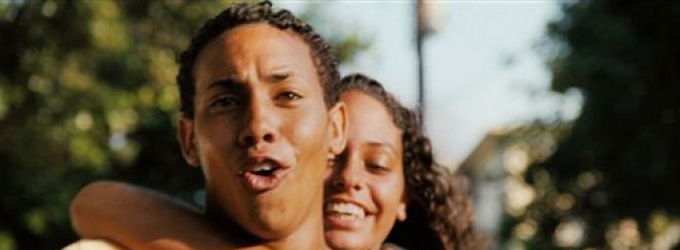
Not much sense of exoticism from Argentina or Turkey then and certainly not a great deal of optimism either in the Cuba of Lucy Mulloy’s UNA NOCHE. The story of two young teenagers planning to make an illegal crossing over the 90 mile stretch of water to Miami in a self-constructed raft is not without some contrivance for the misadventures that lead up to the attempt, but it all serves to bring up several important observations relating to poverty and the lack of opportunity for the ordinary citizen of Cuba. Mulloy’s film very quickly demolishes any picture-postcard image of Havana as a romantic tropical haven, showing police brutality, strict enforcement of segregation between citizens and tourists, unpaid or low-paid labour, prostitution, AIDS, alcoholism and a rather frank depiction of sexual practices of all persuasions. That’s a lot to cover, but the director keeps the script fresh and brimming with incident, while the young cast prove to be engaging in their delivery of the rich dialogue. UNA NOCHE also benefits from some fine cinematography that captures all the grim beauty, colour, flavour and ambience of the locations in a way that perfectly matches the content.
Have I mentioned anything about the BFF programming gritty films with a refreshing lack of sentimentality?
Local cinema or films with a Northern Irish connection are of course an important feature at the BFF and one of the most promising works was a short 24-minute feature by Prasanna Puwanarajah, SPOOF OR DIE. The fact that the director isn’t from the province was probably to the film’s advantage in that it consequently avoided all the usual clichés about the Troubles, but the choice of screenwriter was just as important in this case. Stacey Gregg is making quite a name for herself as a playwright and even as an opera librettist, so the move to film screenplays seems to be a natural direction for a writer with this much talent and ambition. Richard Ayoade’s SUBMARINE inevitably comes to mind in the funny, unsentimental (yes, I’m aware I’m using this word a lot – it’s a theme) and slightly crazy story of young love, or at least friendship. The Troubles realistically form a backdrop for the story but only in as far as it acknowledges the sense of emptiness and dislocation within today’s youth that can lead towards an idealistic view of more “interesting” times in the past. Brought together to make this film for a C4 series, the post-screening Q&A revealed that there’s potential for this creative partnership to work together on further projects. If they can include Michael Smiley in those plans, that would be just great.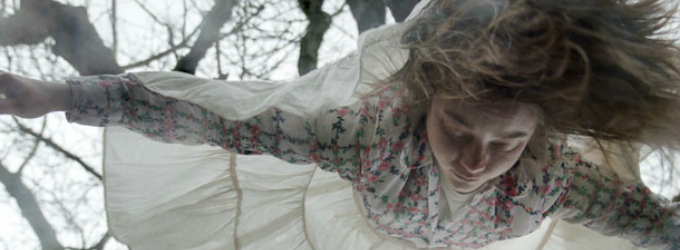
Have I mentioned anything about the BFF programming gritty films with a refreshing lack of sentimentality? Well that’s certainly a description that could be applied to Peter Brosens and Jessica Woodsworth’s THE FIFTH SEASON. Set in a small Belgian agricultural community, the film starts off in the style of one of those quirky little village tableaux films like LE QUATTRO VOLTE, HUKKLE or even fellow Belgian director Bouli Lanners’ surreal comedies, ULTRANOVA and THE GIANTS. It soon develops a rather darker side when the village’s ritual burning of Old-Man Winter doesn’t go according to plan, but when itinerant farmer Pol’s bees fail to emerge the coming Spring, it doesn’t take long for the niceties of civilised behaviour to disintegrate entirely. THE WICKER MAN inevitably comes to mind and even Godard’s WEEKEND in some respects, although it doesn’t quite go as far as the latter’s extremes of cannibalism. The film’s beautiful arty compositions, the superb location cinematography and some intense, nearly wordless performances ensure that the film creates an ambience of desperation and cold desolation that reminds us just how reliant social order is upon the delicate balance of the seasons.
…breathtaking cinematography and an ability to challenge if not just downright offend the viewer’s sensibilities…
Coming from the director of ‘Borgen’, you would expect the same kind of dramatic tension and straight to the point concision in Tobias Lindholm’s first feature film, A HIJACKING. Well, a hijacking is exactly what you get, but not really anything more than that. The hijacking is that of a Danish cargo ship by Somali pirates in the Indian Ocean and the film divides its attention between the drama on the boat from the point of view of the ship’s cook and the protracted negotiations for the crew’s release by the ship’s owners back home. Tensions run high and the human cost is plain to see, but the film is methodical in its unfolding of events rather than inspired. An attempt is made to draw a parallel between big business and piracy in the CEO’s misguided attempts to deal with the hijackers’ demands with hard-nosed business negotiation practices, but the consequences of this approach are clearly signalled in advance and play out according to form. A HIJACKING might not show any qualities over and above those of a superior Danish television series, but that’s still a very high standard to maintain and there is never a moment in the film when the viewer feels anything less than totally involved in the drama. 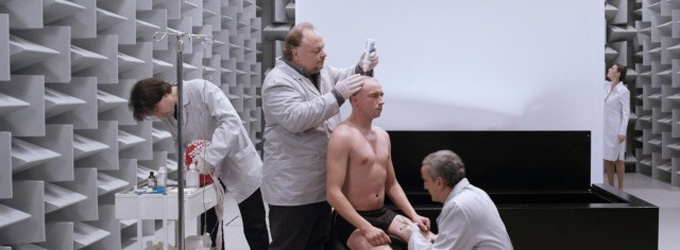
There’s always at least one film in the BFF programme that stands out for the originality of its vision, with breathtaking cinematography and an ability to challenge if not just downright offend the viewer’s sensibilities. Often you’ll find this within the edgy ‘Altered States’ category, and more often than not the film will also come from a former Soviet satellite nation, influenced undoubtedly by the surreal nature of life in those (altered) States. This year that film was undoubtedly VANISHING WAVES by Lithuanian director Kristina Buožytė. The aesthetic and arthouse sensibility of the film inevitably leans towards Tarkovsky, but this is also one of those films that has the reviewer looking for a wider mix of influences in order to highlight its unusual qualities. The BFF programme went for “Stanley Kubrick meets Gaspar Noe”, but for me it was closer to a Lars von Trier remake of ETERNAL SUNSHINE OF THE SPOTLESS MIND by way of SOLARIS. With a scientific research team working on a project to make a connection between the minds of two test subjects, one of whom is a patient in a coma, the impulses of this intimate connection at first are perhaps not unsurprisingly highly sexual in nature, but inevitably it all turns very dark indeed. There is at least huge potential for imaginative, surreal visuals and VANISHING WAVES’ stunning cinematography provides plenty of those. As an exploration of a disturbed mindset in trauma, Buožytė’s film is certainly less pretentious than Von Trier’s ANTICHRIST, but it doesn’t really have anything revelatory to say about the workings of the mind in relation to memory and loss, nor indeed any of the poetry of Tarkovsky’s treatment of those themes.
[PURGE shows] a firmness of purpose and consistency of tone, it’s just that the tone is one of general unpleasantness.
The ‘Altered States’ strand of the BFF also kept up the standard of challenging, thought-provoking cinema with original visions on a science-fiction theme in John Alan Simon’s 2011 film adaptation of Philip K. Dick’s paranoia conspiracy thriller RADIO FREE ALBEMUTH. PDK’s works present considerable challenges for any filmmaker, but none more so than this alternate history where the USA is under the control of a paranoid President of a fascist government. The truth of the regime is revealed to a record-store clerk through messages beamed from space by an alien or divine higher intelligence, but how to alert the rest of the nation to the threat? Based on a true story (sort of), Simon elicits some good performances out of a cast that includes Alanis Morissette as another divine agent of the Vast Active Living Intelligence System and treats Dick’s SF thriller with absolute fidelity to the word and, more importantly, the tone of the work.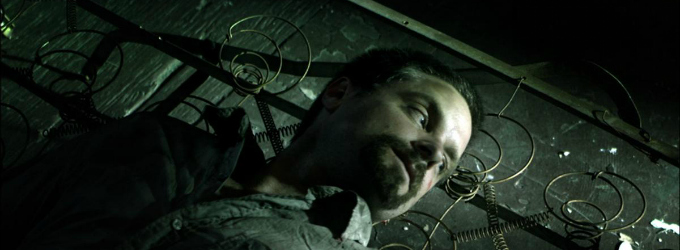
“Uncompromising” is perhaps the kindest way to describe Antti Jokinen’s Estonian-Finnish drama, PURGE. The content is strong, the acting performances are committed, the narrative is clear, showing a firmness of purpose and consistency of tone, it’s just that the tone is one of general unpleasantness. Part of the film is set in the present day, where a very young Finnish girl escapes from a grim life of prostitution at the hands of some brutally violent Estonian human traffickers. The majority of the film however takes place during the post-war years of the Soviet occupation and the Stalinist reign of terror inflicted on the Estonian people. The division between past and present might lead you to question whether the film really knows what it wants to be, but the two strands are evidently linked and it’s by more than just a family connection, the film maintaining a consistent tone in its parallel between the brutality inflicted on people/women living in terror. Some of the scenes of exceptionally strong sexual violence make for grim viewing and the acting is correspondingly pitched at over-the-top, making it hard to find anything really to enjoy here.
[Abbas Kiarostami] aspires to reach the heights of Yasujiro Ozu on his own turf, so to speak. Still no contest.
It hardly seems fair to programme Abbas Kiarostami’s new film LIKE SOMEONE IN LOVE alongside all these edgy young filmmakers trying to make an impression. The Iranian master – and, in my opinion (ahem!), the World’s Greatest Living Filmmaker – gives them a fighting chance by working with an entirely Japanese cast and, just for an extra challenge, aspires to reach the heights of Yasujiro Ozu on his own turf, so to speak. Still no contest. Even in this unfamiliar setting, Kiarostami finds his own rhythm and flow as the film follows a troubled young university student working as a high-class escort. Unsurprisingly, caught up in her own concerns, Akiko can’t see the full range of options available to her, but Kiarostami can and much more besides, presenting the intangible potentiality of the situation with a sense of wonder, magic and mystery. Not much grit maybe, even if there is no sentimentality, but LIKE SOMEONE IN LOVE has a deeply spiritual quality that few other modern directors (Terrence Malick aside) can capture on film. And who can compete with that?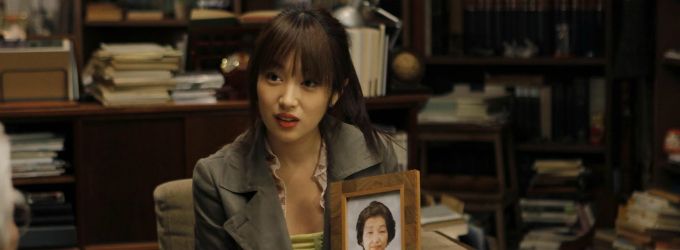
The selection for the Festival’s closing film was a little obvious in as far as it is practically made as a celebration of cinema. György Pálfi’s FINAL CUT is made up of a montage of clips from classic films (it opens with AVATAR and ends with Coppola’s DRACULA), none more than a few seconds long, put together to create a narrative of its own. The method is nothing new – you’ll have seen similar tricks used to promote film seasons on TV or to advertise DVD rentals – but making an 84-minute movie out of it all is more of a challenge. The end result is clever but unimaginative, the narrative nothing more than boy-meets-girl, they date, have sex, get married, break-up and reunite – with a diversion to include war movies during the break-up and a pointless twist that just reuses the one in SUPERMAN 2. If it tends to just highlight the commonality of cinematic language and familiarity of plot points over a century of cinema, it’s hard nonetheless not to be enthralled by the richness of the images themselves. A catalogue of some of the most arresting, iconic moments in the history of the moving image, FINAL CUT reminds us of the vitality and the ability of cinema to touch the collective consciousness of the general public in a way that few other examples of any other artform can. Which is exactly what a good film festival should do.

